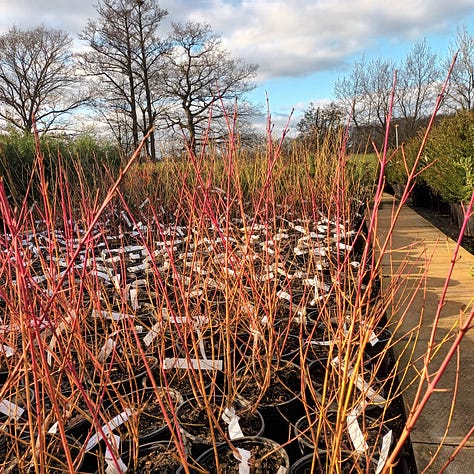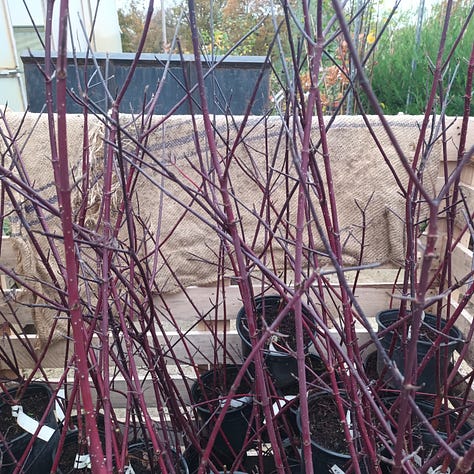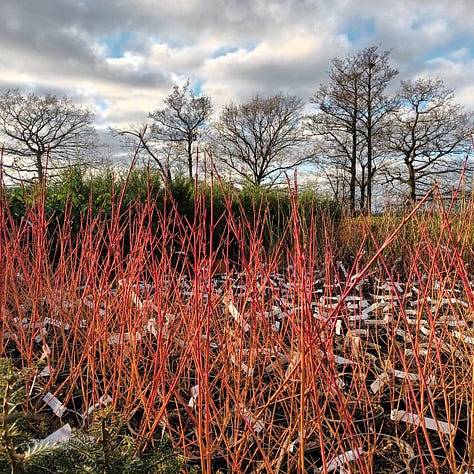Winter Cornus
Today we were preparing for the new bare root delivery, making space and moving crates and crates of bright-stemmed winter cornus. Cornus comes into its own at the dullest time of the year: in November and December. Many varieties have attractive leaves - the pretty, sage-green and cream of C. alba elegantissima, for example. But it is after these leaves have dropped that winter cornus puts on its best show.



The native British cornus is C. sanguinea, which happily grows in hedgerows and the margins of woodlands, preferring damp soil and coping with heavy clay. Its stems are a beautiful garnet red, with a spicy scent when cut, and it can easily grow into thickets of six to eight feet unchecked, though like all cornus it is best kept coppiced back, so its brighter-coloured new growth can shine. Its non-native cousin, C. alba siberica, is smaller with an upright habit, forming wands of deep red colour.
Cultivars include the vivid scarlet ‘Baton Rouge’ the vibrant, orange-yellow ‘Midwinter Fire’ and the softer, apricot-pink ‘Midwinter Beauty’. All of these are compact in habit and low to the ground, making their best impact en masse. The branching, flame-coloured, antler-like stems look amazing when reflected in black winter water, as around the lake at RHS Wisley, or when licking up the white trucks of birch trees, as at RHS Harlow Carr.
There’s something beautifully atmospheric about these burning colours and needle-like stems, at the time of year we associate with bonfires and ghost stories, the first sharp frosts and the tang of smoke in the air. Ghost stories there certainly are. The name ‘cornus’ comes from the Latin for horn: a wood as hard as bone. In Virgil’s Aeneid, the bereaved hero sets sail from burning Troy and lands upon a strange shoreline, where thickets of fire-coloured cornus and myrtle grow. He breaks a branch: the liquid that drops from it is not clear sap, but crimson blood. From deep within the roots of the plant, a human voice issues forth, warning Aeneas to hurry away, lest the iron-sharp twigs take him prisoner too.
Despite this eerie history, in the garden the bright stems of cornus offer a more welcome embrace, drawing the eye with their vivid colours. Nor are they all blood and fire. Less sanguinary in colour is the gorgeous purple-black C. alba kesselringii, whose leaves flush vivid pink before they fall. C. sericea ‘Flaviramea’ is deep, sulphur yellow, with vigorous growth, tending to greenish at the tips: like a shot of sunlight, it brightens up the dark greens and browns of autumn and winter. Other pretty varieties include C. sanguinea ‘Anny’s Winter Orange’ - which is worth it for the name alone - and C. alba ‘Gouchaultii,’ a dark red version with variegated leaves more cream in colour than those of ‘Elegantissima’. All varieties of cornus are excellent for wildlife, providing edible berries and, in the case of the sanguinea family, good nesting sites for birds.
***
Check us out on Instagram: https://www.instagram.com/vertigrowplant/
Vertigrow Plant Nurseries, Lawnswood House, Malton Road, York, YO32 9TL




